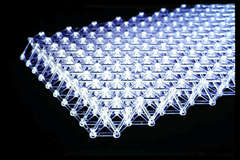| enginuity |
|
home | contents | previous | next |
Engineering materials
An entirely new approach to engineering materials has produced stiff lightweight structures that can be tailored towards a variety of uses. A radical new structural engineering approach towards producing a new material is being undertaken by Professors Norman Fleck and Mike Ashby and Dr. Vikram Deshpande. These so-called 'Lattice Materials' are built up on the principles of triangulation, more commonly encountered in civil engineering. "The notion is to move away from material that is used only for its mechanical properties, and to start looking for multi functional purposes instead" explains Norman Fleck.
Investigations of natural cellular materials show that stiffness degrades faster than relative density but these lattice materials are designed to overcome that problem. Produced by injection moulding and investment casting, the new materials look like miniaturised structural steel trellises more normally seen on a large scale for producing bridges or steel frame buildings. Their geometries are based on the crystal structures found in metals and rocks, however.


Such materials can be produced in sandwich panel form and have potential applications in areas where light weight combined with high stiffness are a requirement, such as in the flooring of aircraft.
Other applications envisaged will make use of the potentially good heat transfer characteristics of these materials for heat exchangers and for cooling electronic components.
Such panels could also be designed to be multi-functional, with the outer layers of a sandwich panel construction consisting of say a solar cell or an electronic membrane. Distributed transistors within the material could be addressed individually to switch shape memory or pneumatic actuators on or off, producing contractions mimicking those of muscles.
At present these materials are being manufactured from aluminium, but they could be made from Ni-based alloys, steels or ceramics. The work is being carried out in conjunction with Harvard, MIT, Princeton and the University of Virginia.
For more information contact Professor Norman Fleck on 01223 332650, e-mail: naf1@eng.cam.ac.uk
| number 9, July 2000 | home | contents | previous | next |